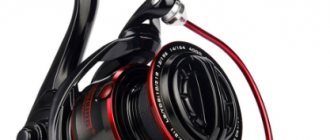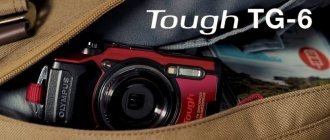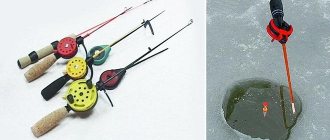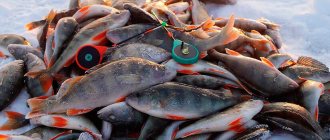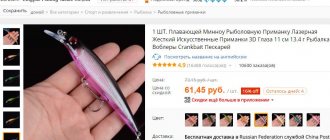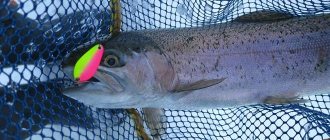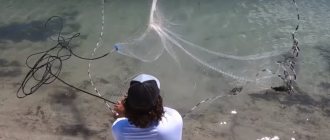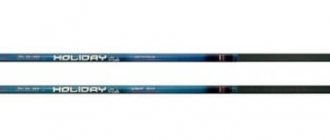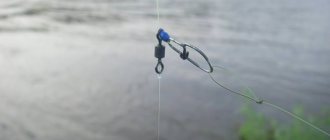Types of winter fishing rods
According to their purpose, professional winter fishing rods are divided into several types:
• jig winter bits;
• fishing rods;
• float bits;
• live bait rods;
• fishing rods;
• bit for the current.
Each type of winter fishing rod has design features and is designed for hunting different types of fish.
Mormuscular
Winter rods for fishing with jigs belong to the Light class rods. These are particularly lightweight structures. You can buy jig winter fishing rods of two subtypes:
• Rewindless. These are most often cheap winter fishing rods of the reelless type. The working line is wound either on the top of the handle. Reelless winter fishing rods have a simplified design and low weight.
• For fishing with bait. Such fishing rods are often called balalaikas. The reel is integrated into the handle; fishing is done using a whip with a nod. Bloodworms work well as bait.
The equipment of winter jig rods is approximately the same for both subspecies:
• The jig is attached either to a leash or to the end of the structure.
• The sinker should be suitable for water with little current.
• The fishing line must be selected with a cross-section from 0.06 to 0.14 mm.
Many fishermen have jig fishing rods in their stash. Even for those who rarely go out for winter fishing.
For glitter
Winter fishing rods for trolling are divided into two subspecies:
• Spinner baits for heavy baits. The blanks of such fishing rods have a working length of 70 to 80 cm and are equipped with at least three guide rings. Reels are used both inertial and non-inertial. The handles of spinners for heavy baits are made from heat-resistant materials.
• Spinner baits for light baits. Such fishing rods must have a reel, a handle and a whip with a nod. Spinner baits for light baits are suitable for hunting perch, for example.
When using a flexible whip, you do not need to install an additional nod. This option is called St. Petersburg.
Float
You can buy a winter fishing rod for ice fishing among the float options. Float rods are similar to jig rods, but have special ice stands. Such designs do not include a nod. Because it is functionally not needed here. The fish bite is noticed by the movements of the float.
The equipment of a winter float fishing rod consists of the following components:
• A hook (or two hooks) for bait (bait).
• A float, by the movements of which you can notice the bite of a fish.
• Sinker for correct positioning of equipment.
• Fishing line. The thickness of the fishing line is chosen depending on what kind of fish you plan to hunt.
When fishing with a float rod, the equipment is completely immersed in water. The float must be covered with water. Otherwise, the water in the hole will freeze and freeze the float.
Live bait
Winter live bait rods are very diverse. Based on their design features, they can be divided into two subtypes:
• Live bait. A rod with a reel and a large nod, equipped with legs for installation on ice. Most often used for hunting rotan and small or medium-sized perch.
• Zherlitsy. Such fishing rods are multi-component. They are equipped with a reel, stands, and flags. These winter fishing rods are used for hunting predatory fish species: burbot, pike, pike perch, and humpback perch. Tackles can be under-ice, upside-down, on legs, or on a vertical (horizontal) platform.
Live bait winter fishing rods vary in price quite a lot. It all depends on the design, materials and manufacturing company.
Postavushi
Their name speaks about the peculiarities of the postavush. These are winter fishing rods equipped with special legs for installation on ice. Fishing with such fishing rods can be called passive. The baits include floats, live baits and for currents, for example.
In addition to these types, winter rods also include winter rods for hunting predators using animal-type bait. With the help of such fishing rods they catch rotan, using a piece of meat as bait. Or, for example, pike perch. In the second case, dead sprat works well as bait.
The hooks are also electronic and with a self-cutting device.
For the current
Buying a fishing rod for winter fishing in water with current is easy. You just need to pay attention to the design. For winter hunting for river fish to be successful, the rod should be as follows:
• The design should be equipped with a reel and a comfortable handle.
• Stable legs must be firmly connected to the main part of the structure.
• The rod must have a whip.
• The rod should also have a nod.
• Additional load on the handle. This will save the fishing rod from flipping over.
• Equipment for fish.
For fishing from ice in water with a current, you need to use a fishing line with a cross-section from 0.18 to 0.25 mm. You can mount the line using a Gardner loop, inline or helicopter.
Features of a winter fishing rod for jig fishing
Fishing rod design
A winter fishing rod used for jig fishing consists of the following components:
- whip - a round cross-section with a diameter slightly varying along the length made of plastic, nylon, vinyl plastic or other polymer material. The whip serves to transmit vibrations of a given frequency from the angler’s hand through the nod attached to it and the fishing line passing through the tip of the nod to the jig;
- reel - used to store the main amount of fishing line, changing its length when moving from one fishing depth to another. The reel consists of a plastic or nylon reel, a simple braking mechanism (a locking lever or a screw that secures the reel tightly after bleeding off the fishing line). Reels on a winter float fishing rod can be either open (the fishing line on the reel is visible, snow and drops of moisture can fall on it), or and closed, built into the handle;
- handle – made of plastic, fine-pored rubber, foam, cork. Its length ranges from 3-5 to 10-12 cm. In sport-type fishing rods - “balalaikas” - there is no handle, and its role is played by the body of the reel into which the reel is inserted.
Temperature during fishing
In most cases, the temperature when fishing in winter ranges from a few degrees Celsius to 10-12 degrees below zero.
At lower temperatures, most jig fishermen do not go fishing - the fishing line freezes very quickly in severe frosts, recently drilled holes are quickly covered with a fairly strong layer of ice, and at low negative temperatures great difficulties arise when attaching small bloodworm larvae to the bait hook.
Good to know! Also, despite the noticeable activation of fish, they do not come out on the ice with significant warming - the ice cover in the bright spring sun very quickly loses its strength, becomes loose and very dangerous for movement on it.
The optimal temperature for jig fishing is from +3+5 C0 to -8-10 C0
Nod

The nod is that part of the jig tackle on which not only the attractiveness of the bait game depends, but also its sensitivity to the most careful and subtle bites.
All this is possible provided that the nod has the following characteristics:
- length 5-10 cm;
- bright, clearly visible color against a white snow background;
- a passage ring or hole at the tip having a diameter such that the fishing line, even when frozen, will pass through it with little effort;
- lack of “memory” - the nod must remain straight and not deform after heavy loads;
- strength – the material of the nod must ensure its flexibility and bending strength;
- frost resistance - the nod must withstand low temperatures without changing its properties.
Modern nods are made from materials such as lavsan, boar hair, and polycarbonate. Much less frequently, but still used, are nods made of flat spring steel.
Note! The nod should be attached to the fishing rod using a rubber clamp - a cylinder with a diameter and height of 3-5 mm, at the end of which there are holes for the tip of the whip and fishing line.
Whip
Despite the fact that the whip is, at first glance, not a very important part of the jig tackle, the catchability of the tackle depends on its length, material of manufacture, flexibility, and frost resistance.
In order for the whip not to spoil the fishing process, it must be:
- 10-15 cm long
- Made from flexible, low temperature resistant material
- The color of the whip should ensure its visibility against the background of ice and snow
Good to know! Just like the whip, like the nod attached to it, should not have “memory” - after the load on it ceases, it should again acquire its original straightness.
Winter fishing rod design
Winter fishing rods have been in use among fishermen for a long time. And the design of such fishing rods can be both simple and very complex.
• Simple winter fishing rods (popularly “fillies”) do not have a reel; the fishing line is wound onto the handle. The fish bite is based on the nod.
• Fishing rods with integrated reels can be called all-rounders for ice fishing. Depending on the equipment, you can catch both small and large predatory fish.
• Sports winter fishing rods are spinning rods for ice fishing. These fishing rods are made of carbon alloy and equipped with multiplier reels.
If you think about “How much does a winter fishing rod cost?”, you won’t find a definite answer. You can buy a winter fishing rod at a price of 350-400 rubles in the category of simple fishing rods. But for more complex designs you will have to pay from 1,500 rubles. The price of sports fishing rods or fishing rods from top manufacturers starts from 3,500 thousand rubles.
Rating of winter fishing rods for trolling
Below are the top 6 fishing rods among Finnish and American models, selected based on reviews from fishermen. Network users assessed the price-quality ratio and, of course, personal experience.
| № | Name | Manufacturer country |
| 1 | Rapala 90/GL230/2-С | Finland |
| 2 | Lucky John C-Tech Perch (43cm) | USA |
| 3 | Teho Bumerang Special | Finland |
| 4 | Suomi 50 | FinlUSANIA |
| 5 | Blue Fox 70 PL | USA |
| 6 | Jonttu 50 | Finland |
Technical characteristics of winter fishing rods
When choosing winter fishing rods, you need to pay attention to the materials from which the structural components are made. More and more anglers are choosing winter carbon fishing rods and carbon fiber alloy rods.
Fishing equipment with plastic parts should be discarded in winter. Plastic freezes and becomes brittle at low temperatures. As a result of these processes, the fishing rod is damaged and becomes unusable.
Fishing rod handles must be made of wood materials. Experienced fishermen can order winter fishing rods from Finland. Finnish fishing rods are known for their quality. Including comfortable handles.
How to choose a winter fishing rod
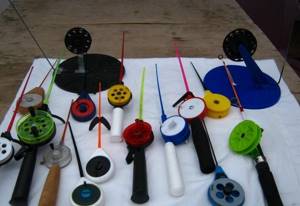
Before you go to a specialty store, you should think about what the purpose of the element is. You need to understand that in certain conditions the strength and flexibility of the whip, the lightness of the entire structure, as well as the material used to make the entire element will play a big role. So, for example, if a fisherman is going to fish in severe frosts, it is better to refuse a fishing rod with a plastic whip, because it may burst. At the same time, it is recommended that the part be detachable.
Fishermen with extensive experience are advised to pay attention to products made of carbon fiber with an open reel lock. The last element is especially important, since water can get into the spring, which will immediately freeze - and this, in turn, will not allow the coil to scroll freely. You can pay attention to the details where the spring is located under the locking lever. A fishing rod with a closed drum may have ice freezing, and this will force the fisherman to resort to constant disassembly. It is best if the drum is large and the handle of the element is made of cork or wood.
If possible, it is better to buy a Finnish fishing rod, which is of high quality and meets all the requirements.
How to choose a fishing rod?
Traditional winter fishing can bring a decent catch and a good mood if you choose the right fishing rod for jigs. Conventionally, such fishing rods are divided into several categories:
- Lure fishing. Flashing is suitable for amateurs. It features simple gear and simple fishing techniques. Used for catching large predatory fish from ice. The design includes a reel, spinners and a fishing rod. Sinkers and floats are not installed. Many expensive models are equipped with comfortable handles made of cork or related materials.
- Fishing with a float. The first steps into the world of fishing are taken with such fishing rods. Helps catch crucian carp, bream and large roach. The gear must be balanced with each other. Designs vary, most often they are used with a “mare” float base.
- Fishing with a jig. The most popular method, which is used during the cold period. There are three categories that differ in design. Leading athletes prefer this type. You can “play” with a high oscillation frequency, which reaches up to three hundred per minute.
When focusing on fishing with jigs, consider the following parameters when choosing:
- Lightness of the fishing rod. Fishing in low temperatures is not easy, so you should take care of comfort. More successful fishing will be with light tools.
- Whip. It is important that it is flexible and comfortable. It is better to focus on a model with a replaceable whip.
- Case material. To make the structure last longer, pay attention to the material. Winter options made of carbon fiber are popular. Options made from fiberglass, carbon, and composite would also be a good choice.
- Form. Affects the comfort of fishing. Handle-shaped fishing rods are well suited for winter. They are light. With them it is convenient to spend a long time in nature doing your favorite activity.
